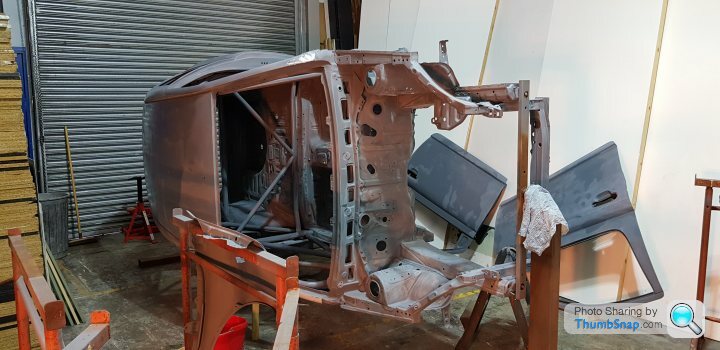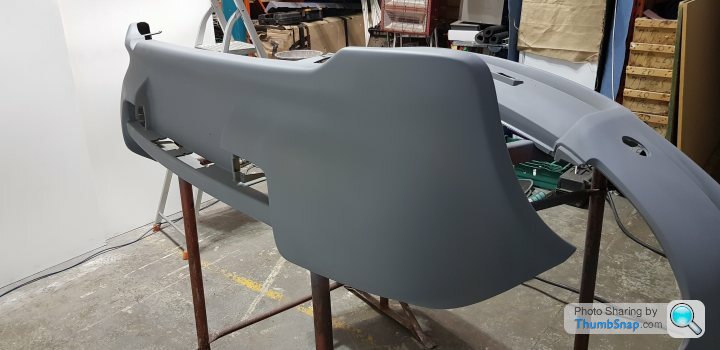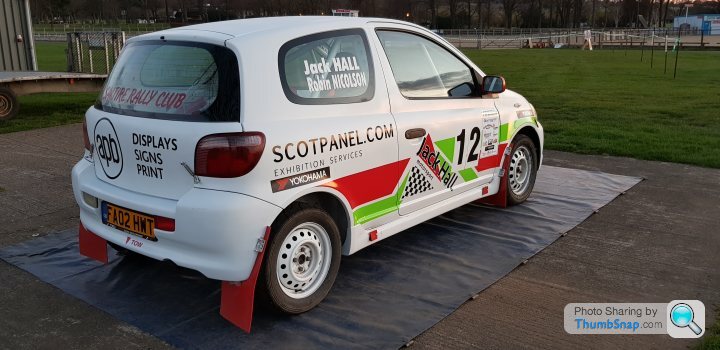2K paint, what do I need?
Discussion
Some advice please for a complete beginner.
Building a rally car with my lad and we are looking to paint it ourselves to help with the (limited) budget. Might as well learn now, so we can repaint / replace panels as the season goes on.
Shell is away at the moment getting blasted and will come back with primer. We have a second car that has been stripped for parts and will start practising on the wings / bonnet of that.
I'm struggling with what I actually need to buy. Base Coats, Top Coats, Clear Coats, Activators, Hardeners?
We will be painting the car White.
What will be the easiest option?
Building a rally car with my lad and we are looking to paint it ourselves to help with the (limited) budget. Might as well learn now, so we can repaint / replace panels as the season goes on.
Shell is away at the moment getting blasted and will come back with primer. We have a second car that has been stripped for parts and will start practising on the wings / bonnet of that.
I'm struggling with what I actually need to buy. Base Coats, Top Coats, Clear Coats, Activators, Hardeners?
We will be painting the car White.
What will be the easiest option?
For a solid white it will be easier to just use topcoat.
Shiny from the gun, doesn't need clearcoat.
Decide which make of paint you intend to use - local motor factor that does paint would be a good idea & you'll likely find they stock one or two makes.
Get the Technical Data Sheets (TDS) and MSDS relevant to that paint & it will tell you everything you need to know.
An example:
TDS: https://buyat.ppg.com/Refinish_SSA/Common/ShowPdf....
Don't forget you will need the appropriate safety equipment to prevent breathing in the fumes & this is usually in the form of an air fed respirator.
Shiny from the gun, doesn't need clearcoat.
Decide which make of paint you intend to use - local motor factor that does paint would be a good idea & you'll likely find they stock one or two makes.
Get the Technical Data Sheets (TDS) and MSDS relevant to that paint & it will tell you everything you need to know.
An example:
TDS: https://buyat.ppg.com/Refinish_SSA/Common/ShowPdf....
Don't forget you will need the appropriate safety equipment to prevent breathing in the fumes & this is usually in the form of an air fed respirator.
Fastpedeller said:
Easiest/cheapest option is to use a single pack yacht paint applied with a brush - it will protect the panels and (if applied in the correct way/conditions) will come out great.
Again, follow the instructions. I've had excellent results on my own boat applying with a roller followed immediately with a high quality brush to 'tip off' which removes any tiny bubbles left by the roller.
http://www.yachtpaint.com/sgp/diy/ask-the-experts/...
You can get car paint for brush application, but again is best applied with a roller & tipped off with a brush. Commonly DIY used on Land Rovers.Tekaloid gets a fair few mentions.
This site worth a read: https://paintman.co.uk/ (NB the Paint Man in this link is not me)
Edited by paintman on Wednesday 5th December 11:59
I dropped in to my local paint supplies shop and had a good chat through all the options.
Settled on Quick Air Drying Acrylic.
Im due to pick up the shell tomorrow. Started putting the primer on the bits that didn't go for blasting. Plastic bumpers etc.
A question though - we have sanded everything and it feels really smooth, but after spraying the primer, it feels rough. Sanded back to smooth again and it seems ready for the Acrylic, but is it the settings on the spray gun that makes the primer feel rough?
Settled on Quick Air Drying Acrylic.
Im due to pick up the shell tomorrow. Started putting the primer on the bits that didn't go for blasting. Plastic bumpers etc.
A question though - we have sanded everything and it feels really smooth, but after spraying the primer, it feels rough. Sanded back to smooth again and it seems ready for the Acrylic, but is it the settings on the spray gun that makes the primer feel rough?
Followed the instructions on the TDS?
Paint improperly thinned, applied from too far away, too rapid movement of spraygun, surface too hot can all result in a 'dry' texture, as the material can't coalesce & flow out.
Spraying other than in a spray booth? Dust in the air will stick to the material.
http://www.standox.com/content/dam/EMEA/Standox/HQ...
Paint improperly thinned, applied from too far away, too rapid movement of spraygun, surface too hot can all result in a 'dry' texture, as the material can't coalesce & flow out.
Spraying other than in a spray booth? Dust in the air will stick to the material.
http://www.standox.com/content/dam/EMEA/Standox/HQ...
Thanks.
Its not in a spray booth, just my workshop, but i dont think its dust. The imperfection is uniform.
Thinned as per instuctions.
Im guessing it will be technique. To far / fast.
I'll have a play about with the spare wings again.
Worst case, and it feels rough when i use the Acrylic, can it be sorted by sanding and polishing?
Its not in a spray booth, just my workshop, but i dont think its dust. The imperfection is uniform.
Thinned as per instuctions.
Im guessing it will be technique. To far / fast.
I'll have a play about with the spare wings again.
Worst case, and it feels rough when i use the Acrylic, can it be sorted by sanding and polishing?
JZZ30 said:
I dropped in to my local paint supplies shop and had a good chat through all the options.
Settled on Quick Air Drying Acrylic.
Im due to pick up the shell tomorrow. Started putting the primer on the bits that didn't go for blasting. Plastic bumpers etc.
A question though - we have sanded everything and it feels really smooth, but after spraying the primer, it feels rough. Sanded back to smooth again and it seems ready for the Acrylic, but is it the settings on the spray gun that makes the primer feel rough?
A bit more thinners and better, more consistent application should sort that out.Settled on Quick Air Drying Acrylic.
Im due to pick up the shell tomorrow. Started putting the primer on the bits that didn't go for blasting. Plastic bumpers etc.
A question though - we have sanded everything and it feels really smooth, but after spraying the primer, it feels rough. Sanded back to smooth again and it seems ready for the Acrylic, but is it the settings on the spray gun that makes the primer feel rough?
Also you will only have a limited window to apply the top coat before you lose the cross linking ability(grip). Your TDS should tell you how long you've got.
JZZ30 said:
Thanks.
Its not in a spray booth, just my workshop, but i dont think its dust. The imperfection is uniform.
Thinned as per instuctions.
Im guessing it will be technique. To far / fast.
I'll have a play about with the spare wings again.
Worst case, and it feels rough when i use the Acrylic, can it be sorted by sanding and polishing?
Sorry for delay in replying, but yes, although sorting the cause to minimise it would be your first course. Its not in a spray booth, just my workshop, but i dont think its dust. The imperfection is uniform.
Thinned as per instuctions.
Im guessing it will be technique. To far / fast.
I'll have a play about with the spare wings again.
Worst case, and it feels rough when i use the Acrylic, can it be sorted by sanding and polishing?
Try sand & polish on a practice piece first just to be sure it will work with your paint.
Fine w&d used wet - a valeter's squeegee will help to remove the water so you can see progress - & machine polish.
You need to guidecoat & flat the primer before you start to apply topcoat.
Any imperfections in the primer will be present & look worse in the topcoats so the final primer coats are your last chance.
If you wet sand it will need to dry out. If you dry sand use a takrag to be sure the surface is dustfree.
Check the instructions in your paint's TDS.
This example is from Lesonal Topcoat:
"Substrate preparation Remove any surface contamination before sanding. Sand with P1000 wet or P500
dry. After sanding work is completed, remove any surface contamination prior to
Topcoat HS 420 application using an appropriate surface cleaner."
http://www.lesonal.co.uk/Products/TDS/L1.03.03_Top...
Any imperfections in the primer will be present & look worse in the topcoats so the final primer coats are your last chance.
If you wet sand it will need to dry out. If you dry sand use a takrag to be sure the surface is dustfree.
Check the instructions in your paint's TDS.
This example is from Lesonal Topcoat:
"Substrate preparation Remove any surface contamination before sanding. Sand with P1000 wet or P500
dry. After sanding work is completed, remove any surface contamination prior to
Topcoat HS 420 application using an appropriate surface cleaner."
http://www.lesonal.co.uk/Products/TDS/L1.03.03_Top...
Edited by paintman on Friday 21st December 20:06
Gassing Station | Bodywork & Detailing | Top of Page | What's New | My Stuff






